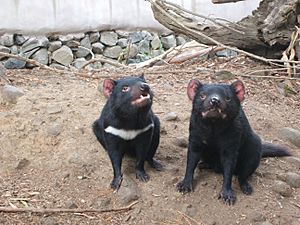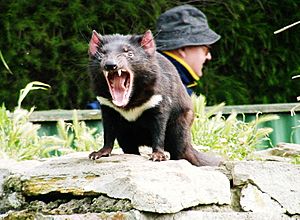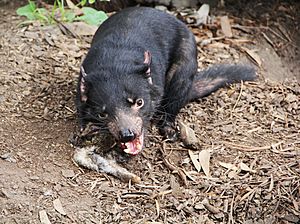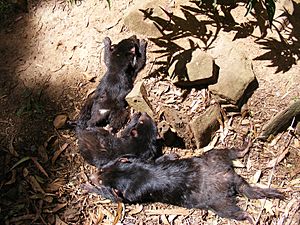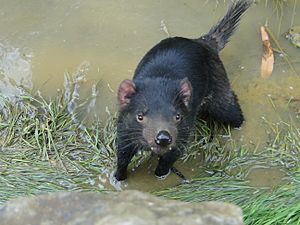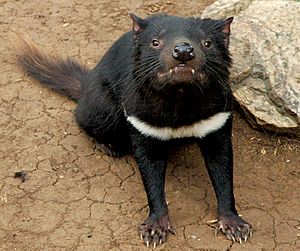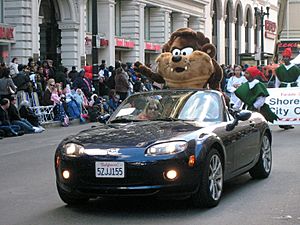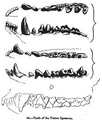Tasmanian devil facts for kids
Quick facts for kids Tasmanian devil |
|
|---|---|
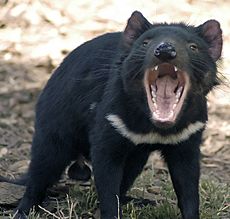 |
|
| Tasmanian devil | |
| Conservation status | |
| Scientific classification | |
| Kingdom: | |
| Class: | |
| Infraclass: | |
| Order: | |
| Family: | |
| Genus: |
Sarcophilus
|
| Binomial name | |
| Sarcophilus harrisii |
|
The Tasmanian devil (Sarcophilus harrisii) is a meat-eating mammal. In Australia, people sometimes call it the Tassie devil. It is also a marsupial, which means it has a small pouch to carry its babies. It is the largest meat-eating marsupial in the world.
Tasmanian devils are nocturnal. This means they sleep during the day and are awake at night. Today, they only live in Tasmania, an island state of Australia.
A devil is about the size of a small dog. It has a wide head and a short tail. Male devils can weigh up to 12 kg and be 30 cm tall. They have black fur and make a very loud, scary screeching noise. Devils hunt other animals and also eat dead animals. They have strong teeth and jaws. They can eat all of their prey, even bones and fur.
Tasmanian devils disappeared from the Australian mainland about 400 years before Europeans arrived in 1788. People used to hunt them in Tasmania. In the 1930s, a company even paid money for each devil killed. But in 1941, they became officially protected by law.
Contents
About the Tasmanian Devil
The Tasmanian devil is the biggest meat-eating marsupial still alive today. It has a strong, thick body with a large head. Its tail is about half as long as its body.
Unlike most marsupials, its front legs are a bit longer than its back legs. Devils can run up to 13 km/h for short times. Their fur is usually black. Many devils have white patches on their chest and bottom. These markings might help them blend in at dawn and dusk. About 16% of wild devils do not have these white patches.
Male devils are usually bigger than females.
Devils have five long toes on their front feet. Four point forward, and one comes out from the side. This helps them hold food. Their back feet have four toes. Devils have claws that they cannot pull back.
Devils are fully grown when they are two years old. Most devils in the wild live for less than five years. One devil named Coolah lived for more than seven years in a zoo.
Devils store body fat in their tails. Healthy devils have fat tails. They also have a scent gland at the base of their tail. They use this gland to mark the ground with a strong smell.
Female devils have a pouch that opens backwards. They have this pouch their whole lives.
The Tasmanian devil has the strongest bite for its size of any living meat-eating mammal. It can bite with a force of 553 N. Its jaw can open very wide, up to 75–80 degrees. This allows the devil to tear meat and crush bones. It can even bite through thick metal wire.
Devils have long claws that help them dig burrows and find food underground. Their strong teeth and claws let them attack wombats that weigh up to 30 kg.
Devils have long whiskers on their face and on top of their head. These whiskers help them find prey when it is dark. They also help devils know when other devils are close during feeding time.
Hearing is their best sense. They also have a great sense of smell. They can smell things from up to 1 km away.
Where They Live
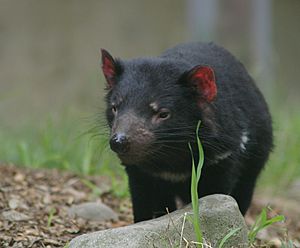
Devils live in all parts of Tasmania. This includes areas near towns. They are found across the main island of Tasmania and on Robbins Island. Robbins Island is connected to the mainland at low tide.
Devils especially like dry sclerophyll forests and coastal woodlands. These are areas with low to medium rainfall in eastern and north-western Tasmania.
Life and Habits
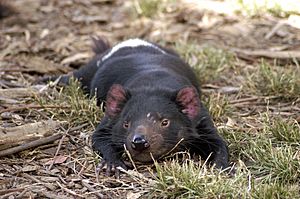
The Tasmanian devil is a nocturnal and crepuscular hunter. This means they are most active at night, and during dawn and dusk. They spend their days resting in thick bushes or in a hole.
Young devils can climb trees. This helps them escape from adult devils, who might eat them if they are very hungry. As devils get older, climbing becomes harder. Devils can also swim. They have been seen crossing rivers that are 50 m wide, even when the water is icy cold.
Tasmanian devils do not live in groups. They spend most of their time alone once they are old enough to leave their mothers.
Devils usually use three or four dens regularly. Old wombat dens are very popular for mothers with babies because they are safe. Thick plants near creeks, tall grass, and caves are also used as dens. Adult devils use the same dens for their whole lives. It is thought that some dens have been used for hundreds of years by many generations of devils.
Devils usually travel around their home area when they hunt. Near human homes, they have been known to take clothes, blankets, and pillows. They use these items in their dens inside wooden buildings.
The devil is a very important animal in Tasmania's ecosystem. It helps keep the environment healthy.
Feeding Habits
Tasmanian devils can hunt animals as big as a small kangaroo. But they usually eat carrion, which is dead animals. They eat dead animals more often than they hunt live ones. Devils like wombats because they are easy to catch and have a lot of fat.
They also eat small native mammals like bettongs and potoroos. Their diet can include farm animals like sheep, birds, fish, fruit, plants, insects, tadpoles, frogs, and reptiles. What they eat depends on what food is available.
Devils can eat all parts of a smaller animal's body, including bones and fur.
On average, devils eat about 15% of their body weight every day.
Young devils sometimes climb trees. They do this to eat grubs and bird eggs. They have also been seen climbing into nests to catch birds.
Even though they hunt alone, eating is a social event for Tasmanian devils. Up to 12 devils can gather to eat a large carcass. Groups of two to five devils are common. They make a lot of noise when they eat together. This noise can be heard several kilometers away. It is thought that they make noise to tell other devils about the food. This way, food is not wasted, and they save energy. The louder the noise, the bigger the dead animal.
Reproduction and Life Cycle
Female devils start to have babies when they are two years old. Male devils fight over females during the breeding season.
Pregnancy lasts for 21 days. Female devils give birth standing up. They have 20 to 30 tiny babies. Each baby weighs about 0.18 to 0.24 g.
Tasmanian devil babies are called "pups," "joeys," or "imps." Once inside the mother's pouch, they attach to a nipple for about 100 days.
Inside the pouch, the babies grow quickly. Their eyes open when they are about 87 to 93 days old. They can let go of the nipple at 100 days.
They leave the pouch about 105 days after birth. At this point, they look like small versions of their parents and weigh around 200 g. After leaving the pouch, the young devils stay in the den for about three more months. They start to go outside the den between October and December. They become independent in January.
Devil Genetics
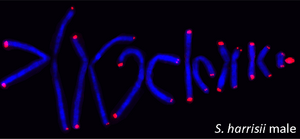
Tasmanian devils have low genetic diversity. This means there is not much variety in their genes. This happened because a small number of devils came to Tasmania from Australia a long time ago. So, their genes were less varied than the original group.
Diseases, like the one they face now, might have happened before. These events can reduce the devil population to a very small number. This is called a 'population bottleneck'. A small population with less genetic variety is always at risk of extinction. This is because none of the animals might be able to fight off an infection.
Scientists studied the devil's genes in 2010. There is hope for their survival. Since 2005, three female devils have been found that are partly resistant to the disease.
In Popular Culture
The devil is a famous animal in Australia. It is especially linked to Tasmania. The animal is the symbol of the Tasmania Parks and Wildlife Service. A former Tasmanian football team was called the Devils. The Hobart Devils were once a basketball team. The devil has also been on many special coins in Australia. A ginger beer in Tasmania has a Tasmanian devil on its label. In 2015, the Tasmanian devil became Tasmania's state emblem.
Tasmanian devils are popular with tourists.
With its unique personality, the Tasmanian devil has been in many documentaries. It has also been in fiction and non-fiction books for children.
The Tasmanian devil is probably best known around the world because of the Looney Tunes cartoon character. This character is called the Tasmanian Devil, or "Taz." He first appeared in 1954. Taz is a loud, super active cartoon character. But he is not much like the real animal.
After a few short cartoons between 1957 and 1964, the character was not used for a while. Then in the 1990s, he got his own show, Taz-Mania, and became popular again. In 1997, a newspaper said that Warner Bros. had "trademarked the character and registered the name Tasmanian Devil." This trademark was protected. For example, there was an eight-year legal case about a Tasmanian company wanting to call a fishing lure "Tasmanian Devil."
Images for kids
-
An 1808 drawing featuring the Tasmanian devil and a thylacine by George Harris
-
Tasmanian devil skeleton on display at the Museum of Osteology, Oklahoma City, Oklahoma
-
Tasmanian devil skull in The Museum of Zoology, St. Petersburg, Russia
See also
 In Spanish: Demonio de Tasmania para niños
In Spanish: Demonio de Tasmania para niños



